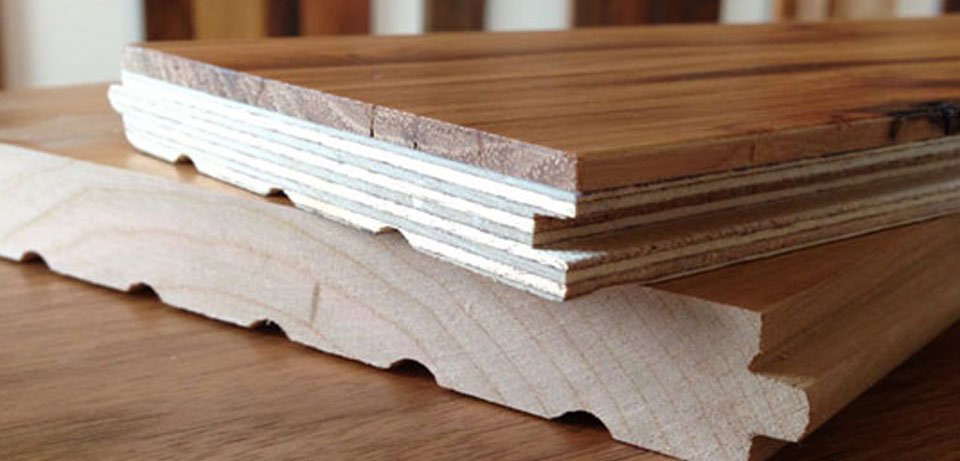When it comes to choosing the right type of flooring for your home, you must consider several factors such as cost, durability, and maintenance. Laminate, engineered hardwood, and solid wood flooring each have their advantages and disadvantages. Which option is best for you? Let’s look at some of the pros and cons of each option to help you make an informed decision on what type of material to use in your upcoming flooring project.
Laminate Flooring vs Vinyl
For starters, laminate flooring is made of four layers and is often confused with vinyl plank flooring. Just like vinyl plank flooring, it has a top layer that is waterproof, however, the similarities end there. Vinyl plank flooring has a back layer made of fiberglass, PVC, and vinyl, while laminate does not. The bottom layer is moisture resistant and provides balance to the floor and assists in keeping the boards straight and prevents warping. The core is made of pressed wood pulp, particleboard, and is the thickest layer. On the other hand, the design layer is a high-definition picture. The top layer, the wear layer, is a clear topcoat that protects the high-definition picture and the core underneath from external damage.
Although unlike vinyl, laminate is not waterproof. The pressed core layer is wood and runs the possibility of warping if exposed to moisture. Due to the wear layer, laminate is more resistant to moisture than traditional solid and engineered wood flooring. It is perfect for high foot traffic areas, and places where moisture is more prevalent. For these reasons, it is a good choice for bathrooms, laundry rooms, and kitchens.
Engineered Wood
Unlike laminate, Engineered hardwood is also made from plywood and wood. Although both are made using adhesives, high pressure, and heat, engineered wood is 100% real wood which means it is more resilient to moisture than traditional hardwood. Similar to laminate wood, engineered wood is a floating floor and can be installed in multiple places where traditional solid wood cannot and is usually installed with a locking system, just like laminate.
Solid Hardwood
Traditional solid hardwood floors are made of a single piece of wood with tongue and groove edges while originating from a variety of different trees. Traditional solid hardwood must be sealed and then finished. The sealant protects the wood from the finish and allows for more color options. Although unlike engineered wood or laminate, solid hardwood should not be used in high traffic areas or places subject to moisture and its installation is limited to wood subfloors. Solid hardwood also needs to be nailed or glued down and can’t be put on top of surfaces like concrete.
How to Choose the Best Flooring for your Home or Business
Now that you have a basic understanding of how laminate, engineered, and solid wood floors are made, how do you make the correct choice for your flooring needs? If you are looking to put your flooring in an area that can be exposed to slight moisture, then laminate and engineered hardwood are better options than traditional solid wood. If the area is also subject to high foot traffic and excessive wear, then laminate is a better option over engineered wood. If you don’t have a subfloor that is made of wood, then traditional wood flooring is not an option. For example, if you live in a slab house or have a basement made of concrete that you want to cover, you must either use laminate or engineered hardwood. Both are floating floors and don’t require nails or glue to be installed.
If you are looking for the traditional look of wood, you can’t beat engineered or solid wood flooring. The natural elegance of both is hard to replicate in a picture. Engineered and solid wood both have a depth that can’t be replicated by laminate. Between the two, engineered wood is slightly easier to maintain, and you don’t have to worry about the wood shrinking or expanding depending on the time of year. Just like solid wood, you can sand engineered wood if it gets scratched or damaged. However, you can usually only lightly sand it, and only once or twice before the flooring needs to be replaced. With solid wood, you can sand it as much as you want until you get down towards the bottom of the wood plank.
If durability and cost are a concern, laminate is probably the best choice. Laminate is much more durable than engineered or solid wood. The wear layer prevents it from chipping or being dented. Also, laminate flooring usually cost less than traditional solid or engineered wood floors.
Conclusion
You have several options when you decide to replace or add wood flooring to your home or business. To choose the right type of flooring, it is important to look at the specific situations of each room to decide on the correct fit. If moisture is an issue, then traditional wood is probably not a good choice. If cost and durability are important, then laminate might be the way to go. If you want a true three-dimensional look of traditional wood floors, you can’t beat solid wood. If you find that you want a balance between the depth of your flooring and its durability, engineered hardwood might be the best choice for you. With all the current options available for flooring, the possibilities are almost endless. Click here to browse our collection of engineered hardwood flooring! As always, you can contact us to request samples entirely free of charge.

